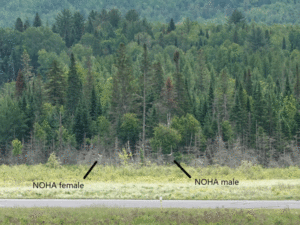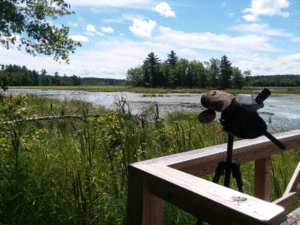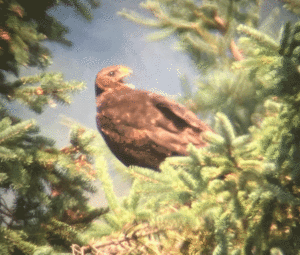(by Chris Martin)
NH Audubon recently wrapped up our third straight year of full breeding season (May-August) monitoring of state-endangered Northern Harriers. Overall, the 2022 breeding season was a pretty good one for New Hampshire’s harriers. Fieldwork in Coos County – the core of this raptor’s breeding range in the state – revealed six successful nests that fledged 15 juveniles, a big jump over 2021, when we found only two productive nests that fledged just three young.

A century ago, harriers likely nested statewide near freshwater and saltwater marshes, large beaver meadows, and other natural and human-made openings. Agricultural practices in the 1800s created an extensive mosaic of fields and edges that turned many spots into suitable harrier habitat. In more recent decades, development and forest succession both have reduced this acreage. So today, compatible management practices in open habitat is even more critical if we hope to see harriers continue as a breeding species in the Granite State.

NH Audubon has been doing harrier fieldwork for the past several years with federal State Wildlife Grant support from NH Fish and Game. Prior to 2019, no formal harrier surveys had taken place anywhere in the state since 1997. Our primary goal for our current studies is to find where active territories are located and monitor nest outcomes. While we have focused mostly on towns near Colebrook, we have also checked historical and potential breeding habitat elsewhere in the state. No successful nesting has been detected south of Coos County either in 2021 or 2022 even though volunteers have checked key sites in Carroll, Grafton, Hillsborough, Merrimack, and Strafford counties.
In 2022, we were lucky that raptor enthusiast Katrina Fenton returned as our North Country harrier field tech. A part-time Coos County resident, Katrina knows the hayfields and backroads of the state’s northern fringes better than most, and her keen eye and boundless patience have been vital to this project’s overall success. Over the past few summers, Katrina (along with her partner-in-crime Levi Burford) spent countless hours watching from roadsides, walking tractor paths through hayfields, and scanning marshes in places best-known for their quirky names, like “Bungy” and “Creampoke.”
Hidden on the ground in brushy patches of red-osier dogwood and willow, harrier nests aren’t easy to spot. It’s important to find breeding pairs in early Spring while they are active in courtship and nest-building, when there are twice as many birds out and about to be seen, frequent intervals of territorial defense, and lots more vocalizing! Once females settle into their month-long solo incubation, things can get very quiet. And male harriers often hunt far away from nest sites to find enough food for sitting females and their hungry hatchlings. Finally, in August, juvenile harriers show themselves after weeks of concealment. The first half of August is the time to “count heads” as awkward fledglings begin to fly.

Next steps for this project – in addition to continued monitoring – likely will include reviewing three seasons of breeding data, consulting with biologists at NH Fish and Game and other North Country wildlife managers, and creating a list of management options that can benefit this State-listed endangered bird.
